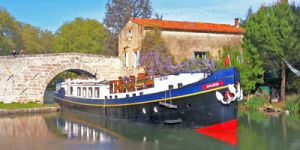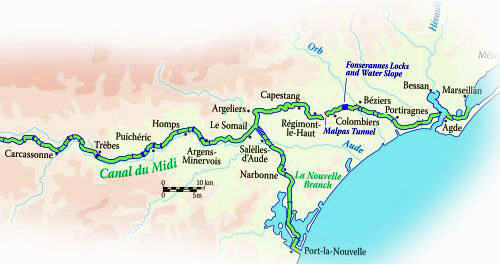ANJODI

Canal du Midi
Up to 8 guests
Charters and Cabin cruises
Themed charters:
Family, Golf, Wine Appreciation

A water route across France between the Mediterranean and the Atlantic had been long sought by those wishing to avoid the arduous journey around Spain and the Strait of Gibraltar.
The Canal du Midi joins the Canal de Garonne at Toulouse. These two waterways form the Canal des Deux Mers (Canal of the Two Seas)
The goal was to create a waterway that would allow transport of passengers and cargo from the Mediterranean to the Bay of Biscay while avoiding the long (up to one month) and dangerous (e.g., Barbary pirates) sea voyage through the Strait of Gibraltar. Augustus and Nero thought about it back in their day. Charlemagne considered it in the 8th century. King François I brought Leonardo da Vinci to France in 1516 and commissioned a survey of a route from the Garonne at Toulouse to the Aude at Carcassonne. It took a wealthy salt tax collector in the 17th century to bring the idea to fruition.
Pierre-Paul Riquet (1604-1680) of Béziers supplied the vision, the drive, and even part of the financing for the Canal du Midi. In 1660, King Louis XIV’s chief financial advisor, Jean-Baptiste Colbert, noted that France’s international trade of wine and grain was in decline, and that the Dutch and the Spanish were making the most of the situation. The crisis caused land values to fall and many small farms were going bankrupt. The Languedoc region was also experiencing religious conflicts and was difficult to govern, including tax collection.
Colbert saw Riquet’s proposal for the Canal du Midi as a way of pursuing an economic expansion of the Languedoc in the service of the Monarch. This idea was brought to the attention of the King in 1665. The canal offered the political and economic benefit of bypassing Gibraltar, which was controlled by the Spaniards, and would therefore destroy their trade and establish an alternative commercial route through the Languedoc. The Languedoc had many resources too, such as wine from Minervois and Corbières, wheat, woolen cloth, silk, and salt, which producers were struggling to export due to lack of trade routes. By passing through the Canal du Midi, Colbert hoped to distribute goods in the different regions of the south, thereby strengthening royal power and opening up Toulouse and its region to the outside world.
In 1666, an edict by Louis XIV and Colbert proclaimed that construction could begin. They excavated seven million cubic meters of earth and employed over 12,000 men and women over 12 years for the project, which was a huge undertaking for its time. The canal was ceremonially opened in October 1681, a few months after Riquet died.
The Canal du Midi would not only enable the more efficient transport of goods, but would also help the military and add to the mobility of the French navy. Covering 150 miles, it includes 328 structures such as locks, tunnels, bridges, and aqueducts. The canal’s 63 locks include double, triple, quadruple, and sextuple staircase locks.
The canal has changed little in its 300 years. Lock gates are now steel rather than timber. An aqueduct was built to create a waterway over the River Orb in the 19th century, and a short-lived water slope at Béziers allowed boats to avoid the six-rise flight of locks. In 1996, UNESCO declared the Canal du Midi a World Heritage site.
The high quality of construction that went into the locks, aqueducts, and buildings has ensured that the Canal du Midi, the oldest canal in Europe, still functions. It is the most popular canal for leisure boaters in France.
French Hotel Barge Anjodi Moored Under the Plane Trees
A variety of trees were planted along the banks to provide shade for the haulage mules. This line of mostly plane trees forms a huge green arc over the canal. In recent years, the plane trees have been infected with canker stain, a disease caused by a microscopic fungus called Ceratocystis platani. This has meant the slow but steady felling of all 40,000 trees along the waterway. The plane trees are being replaced mainly by other species (ash, lime), after initial experiments with a variety of plane-tree resisting the parasite.
Learn more about the Canal du Midi:

Canal du Midi between Carcassonne and Marseillan, France
Click for videos featuring the canal du midi
HOME > REGIONS > France > Canal du Midi > Overview